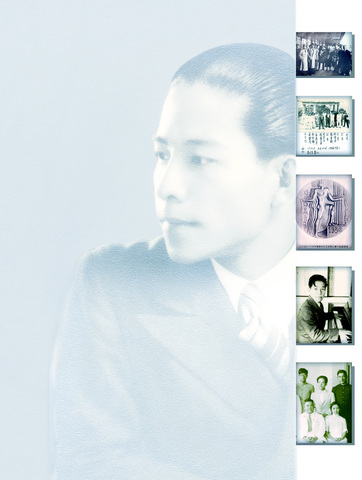Although the talented Taiwanese musician Chiang Wen-yeh (
Chiang's Formosan Dance (台灣舞曲), which he composed in 1933, brought him fame. However, success did not guarantee him a better life. The musician's fate was inter-twined with Taiwan's sometimes bitter and harsh history.
Like many Taiwanese during Japan's colonial rule over the country from 1895 to 1945, Chiang frequently faced awkward choices.

The Japanese rulers treated members of the public like Chiang as colonial subjects and second-class citizens. But in China he was viewed as Japanese and a traitor.
After the Chinese Nationalist Party (KMT) took control of Taiwan, Chiang's music was banned by Chiang Kai-shek's regime.
A couple of years before the artist's death in 1983, several Taiwanese musicians used Chiang's Japanese name Bunya Koh to evade government censorship and perform his music in Taiwan.
His compositions include at least five orchestral master-pieces, a number of piano sonatas, ballads, symphonic poems, sinfoniettas and hymns.
Chiang was born on June 11, 1910 at Dadaocheng (
It quickly became apparent that he was a musical prodigy.
It was said that Chiang, at the age of three, could perfectly mimic children's songs which his mother sang to him. Aged five, he was accomplished at singing hymns which he learned from listening at the window of a local church.
His father, Chiang Chang-sheng (江長生), a successful merchant, moved his family to Amoy (廈門), Fujian Province, China, to study at a Japanese-run elementary school.
Chiang's mother Zheng Gui (
In 1923, after the death of his mother, Chiang was sent, along with his brothers, to Japan to continue his education.
In March 1928, Chiang registered at a Japanese technical school to study electrical engineering in accordance with his father's instructions.
Meanwhile, he attended night school to learn music.
Chiang completed his first major work, Formosan Dance, in Tokyo in 1933.
Based on the pentatonic scale, Chiang later rewrote the Formosan Dance from a piano version to a full orchestral work. The new version was chosen along with four other Japanese musicians' works to represent Japan at the Olympic arts competition in 1936.
In addition to his natural musical talents, Chiang benefited greatly from the teachings of Alexander Tcherepnin, a Russian musician who was teaching at the Shanghai Music Conservatory and visited Japan to perform in 1934.
Chiang and Tcherepnin met at an event organized by Japan's Composers Alliance Club.
Through Tcherepnin's guidance, Chiang was exposed to the work of great European composers and learned techniques employed by Claude Debussy, Bela Bartok and Igor Stravinsky.
Among his other compositions, Bagatelles (
With success came recognition as an internationally renowned composer.
However, Japan's invasion of China in July 1937 changed the course of Chiang's life.
After taking control of Beijing, the Japanese government organized a Cultural Film Bureau (文化映畫部) and appointed Chiang to compose music for the propaganda it produced.
In the Spring of 1938, fellow countryman Wang Cheng-ho (
In Beijing, Chiang wrote songs for the Japanese military-backed New People's Society of Beijing (
In June 1945, a few months before the US dropped atomic bombs on Hiroshima and Nagasaki, Chiang lost his teaching post at Beijing Normal College.
His job was taken by a Japanese professor.
After the Sino-Japanese war ended in October, Chiang was accused of collaborating with the Japanese by writing propagandist songs and was jailed for 10 months by the KMT government.
After his release, Chiang was introduced by a fellow former prisoner to Italian Franciscan Friar Gabriele Allegra (雷永明神父) in Beijing who encouraged the musician to compose hymns for the Sigao Bible Society.
From 1946 to 1948, Chiang, who had never been a practicing Catholic, wrote four volumes of hymns using his favorite pentatonic scale. Many of the hymns written by Chiang are still sung by Catholics in Taiwan, Hong Kong and China today.
Life took a dramatic turn for the worse after the Communists consolidated their grip on China in 1949.
After Chiang Kai-shek's defeat at the hands of the People's Liberation Army, the musician decided to stay in Beijing where he obtained a teaching job at the Peking Art School (
At the beginning of the so-called "New China" regime the future looked good for Chiang. He was invited to assist the establishment of the Central Conservatory of Music (
The then-dean of the Conservatory was the internationally renowned musician Ma Shih-t'sung (
Chiang was not nearly as lucky.
He was branded a "reactionary rightist" in 1957 and lost his professorship after Chairman Mao Zedong (
For 10 years he lived with his family on a librarian's meager income. The Cultural Revolution dealt the talented musician another blow in June 1966.
He was sent to clean public toilets at the initial stage of the so-called revolution and his family was raided by the Red Guards. His records, books, music scores and hand-written notes were all confiscated.
Aged 60, he and his other colleagues at the Central Conservatory of Music were transferred to Baoding County (
His health subsequently deteriorated, but his love for music remained unyielding.
The year 1976 saw the downfall of the "Gang of Four" in China and the Cultural Revolution came to an end. Two years later Chiang's case was reassessed and he was allowed to return to Beijing where he started composing The Songs of Ali Mountain, based on his childhood memories.
He was paralyzed after a stroke, possibly triggered by the years of hard labor he had endured. He never recovered, dying on Oct. 24, 1983 in Beijing. His last orchestral piece remains unfinished. (For further information, visit www.taipeimusic.org.tw)
(Translated from Mandarin by Derek Lee)

That US assistance was a model for Taiwan’s spectacular development success was early recognized by policymakers and analysts. In a report to the US Congress for the fiscal year 1962, former President John F. Kennedy noted Taiwan’s “rapid economic growth,” was “producing a substantial net gain in living.” Kennedy had a stake in Taiwan’s achievements and the US’ official development assistance (ODA) in general: In September 1961, his entreaty to make the 1960s a “decade of development,” and an accompanying proposal for dedicated legislation to this end, had been formalized by congressional passage of the Foreign Assistance Act. Two

March 31 to April 6 On May 13, 1950, National Taiwan University Hospital otolaryngologist Su You-peng (蘇友鵬) was summoned to the director’s office. He thought someone had complained about him practicing the violin at night, but when he entered the room, he knew something was terribly wrong. He saw several burly men who appeared to be government secret agents, and three other resident doctors: internist Hsu Chiang (許強), dermatologist Hu Pao-chen (胡寶珍) and ophthalmologist Hu Hsin-lin (胡鑫麟). They were handcuffed, herded onto two jeeps and taken to the Secrecy Bureau (保密局) for questioning. Su was still in his doctor’s robes at

Last week the Democratic Progressive Party (DPP) said that the budget cuts voted for by the China-aligned parties in the legislature, are intended to force the DPP to hike electricity rates. The public would then blame it for the rate hike. It’s fairly clear that the first part of that is correct. Slashing the budget of state-run Taiwan Power Co (Taipower, 台電) is a move intended to cause discontent with the DPP when electricity rates go up. Taipower’s debt, NT$422.9 billion (US$12.78 billion), is one of the numerous permanent crises created by the nation’s construction-industrial state and the developmentalist mentality it

Experts say that the devastating earthquake in Myanmar on Friday was likely the strongest to hit the country in decades, with disaster modeling suggesting thousands could be dead. Automatic assessments from the US Geological Survey (USGS) said the shallow 7.7-magnitude quake northwest of the central Myanmar city of Sagaing triggered a red alert for shaking-related fatalities and economic losses. “High casualties and extensive damage are probable and the disaster is likely widespread,” it said, locating the epicentre near the central Myanmar city of Mandalay, home to more than a million people. Myanmar’s ruling junta said on Saturday morning that the number killed had